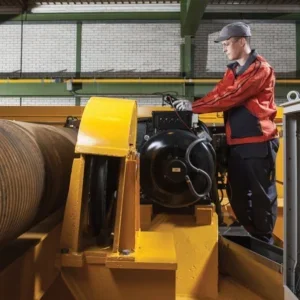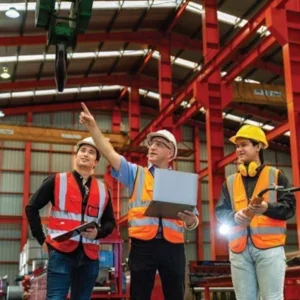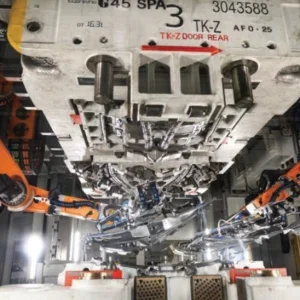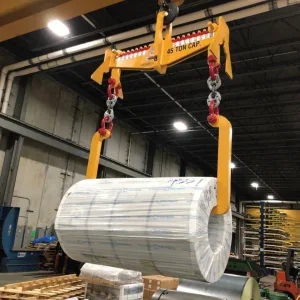Operating cabs on mobile cranes could, one day, become a thing of the past, according to some remote control industry insiders. And, they say, there are very good reasons why.
Gerry Barker, managing director of Koppen & Letham, distributor of Swedish-made Scanreco remote control systems used widely in the crane industry, believes that remote control is always a safer option than operating a crane from a cab. For example, operators can position themselves away from the vehicle giving them better visibility when dealing with a load, he says.
And, as he points out, the banksman – the person receiving the load from the crane operator – is not always qualified. Using remote control dispenses with the need for a banksman, so the operator does not need to depend on someone with insufficient qualifications, he says. Besides, remote control saves on manning – one skilled operator can deliver the load without help.
Straightforward systems
Barker adds: “The only disadvantage to using remote control is the perception that it requires the use of advanced technology. This is not the case. These systems are designed to be straightforward and carry out the work without the need to apply advanced technological knowledge.”
James Robertson of remote control giant Cattron Group International, which claims to be the world’s leading manufacturer of portable industrial radio remote control systems, agrees. “The use of remote control allows work to be carried out with greater safety and greater efficiency,” he says.
“It removes the need for two people to contact from the ground to the cab. With this comes the advantage of visibility and, therefore, jobs can be carried out with greater speed and accuracy. For example, operators can be more precise about where they put down loads.”
Robertson believes that the industry is on the cusp of an era where cranes are operated completely by remote control. He says: “It is becoming widely accepted now that remote control is a good thing. Some of the people who were brought up with the old ways of doing things have taken time to come around to the idea of remote control. With some people it was a trust thing of knowing that when you asked a crane to move left on a remote control it was actually going to move left. People accept that it will now.”
Demise of the operating cab
It is unlikely that cranes will ever become completely automated, but Robertson believes that a time will come when operating cabs are a thing of the past. “Remote controls are designed to imitate the controls normally found in the cab to enable those with experience to make the transition,” he says.
Wolfgang Beringer, head of sales promotion at mobile crane manufacturer Liebherr-Werk Ehingen, has charted the progress of remote control over the years. He says: “Fewer than 5 per cent of our cranes are purchased with remote control, and those that do have it are usually below 100t. The current trend is that the sale of remote control is increasing, but only slowly. When larger cranes are in operation, there are still many workers around.”
The spokesman for another mobile crane manufacturer, Terex Demag’s Christian Schorr-Golsong, is also wary about stating that remote control has a big future in mobile cranes. Remote control has, in the past, been limited to self-erecting and loader cranes and, although it is an option on some mobile cranes, Schorr-Golsong does not believe it will take off in the same way: “When working around buildings it can make it easier for operators, but they wouldn’t use it all the time,” he says. “Because of the nature of the work it would only be used on mobile cranes from time to time. Why would a company want to pay for something they didn’t always need? Remotes make the use of self-erectors and loaders easier all the time. This isn’t the case on mobiles.”
But he admits: “There are benefits to remote control. It helps operators work around blind corners, for example. Where the use of radio control between two workers is needed, one operator can position himself accordingly.”
Gerhrard Kaupert, design director at Manitowoc, is another industry expert who does not expect the use of remote control on mobile cranes to rise significantly. In fact, he suggests that no more than 5 per cent of mobiles will ever use remote control. “At the moment, about 2 per cent of our mobile cranes are operated with remote control,” he says. “This has remained consistent, and I don’t think this number will ever grow beyond 5 per cent.”
Manitowoc is working with Hetronic to provide remote control in its mobiles, according to Kaupert, but he says mobile crane operators prefer to work in the cab most of the time. “It is also an expensive option. Sometimes, if one operator is working on his own then customers will ask for remote control, but that is rare.”
Besides, he adds: “A mobile crane operator needs to be able to sit in the cab to feel the crane react to movements, and react to contact.”
Unsurprisingly, given that remote control is far more common on knuckle-boom cranes, Jim Smith of loader crane manufacturer Atlas Terex disagrees: “Remote controls can be ultra sensitive, and can give the operator a better feel for the crane’s movements than he could achieve from the cab. It is true that some mobile cranes will never be fitted with remote control as standard, but the demand for it will grow,” he predicts.
Joseph Mairfoels of remote control supplier Hetronic, is also upbeat about the future of remote control technology. Indeed, he believes it is possible that, one day, all cranes – including mobiles – will all be operated by remote control. He says the growth in demand for remote controls has been huge over the past three years, and he expects the trend to be continue: “The only time people may be reluctant to use it will be on small cranes where it might not make economic sense to upgrade to remote control,” Mairfoels says.
Brian Ball, managing director of remote control company Simbal, has witnessed a huge rise in demand for remote control in other, more traditional, applicants in the market.
“The lorry [loader] crane remote control market was always good in Europe,” he says. “But it increased dramatically over the past year in the UK. People have become used to the idea that safer is better.”
No safety guarantees
However, a remote control does not automatically make a crane safe, as Antonio Silvestri, product development manager for remote control company Autec, warns. He believes that remote control is the safest way to operate a crane, but has two caveats.
First, operators must be fully trained before they pick up a remote control system. The outcome could be no less disastrous if someone, without the necessary qualifications operated a crane from a handheld joystick than if they climbed into the cab, he says.
Secondly, operators must make sure they are always in full sight of the crane. A crane will respond to remote control regardless of what the operator is looking at. As Silvestri puts it, operating a crane without clear sight of the machine would be as senseless as driving the wrong way up a road.
He concludes: “As long as the warnings and guidelines are followed, it is a safe and effective way of operating a crane, and demand for it will grow.”
Marco Nicolini, sales manager at 3B6 Electronics, which also makes remote controls for cranes, makes the point that new technology can sometimes be a hindrance. For example, if a crane heavily reliant on electronics and remote control breaks down, it requires specialist attention from a person trained in that field. Nicolini says that this expertise may not always be readily available.
It is this school of thought that could eventually lead the industry to a greater knowledge and acceptance of remote diagnostics. Remote control allows an operator to work a machine from a few feet away, while remote diagnostics allows a machine to be monitored and repaired from the other side of the world. It is a facility whereby one can access the program of a piece of equipment indirectly. Typically, this is done by dialling into the equipment using a telephone line and modem. Hence the ability to interrogate, interact with, and change the program from a distance.
For example, remote diagnostics can monitor the condition of a machine so that the service engineer is aware when a part needs replacing. The necessary components could be sent to the site in advance to ensure they would be ready for the maintenance to be carried out. This would avoid the delay that can occur when a service is needed, but the engineer has to wait for spare parts to be delivered.
Schorr-Golsong believes that the industry will warm to the idea of remote diagnostics, but is cautious about the speed of its uptake. “We’re finding that customers are still careful with its use because the system is new to them,” he says. “People are cautious with new technologies. But it will grow. We’re only just starting with it, but I expect to see a lot of growth over the next two years.”






